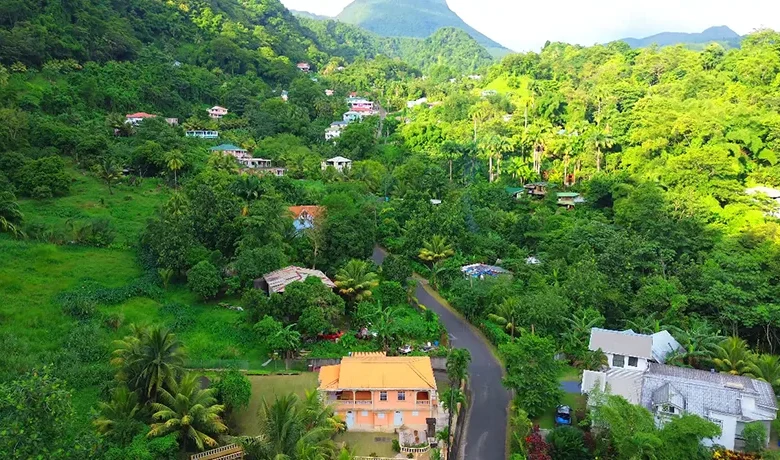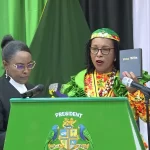Trafalgar

Trafalgar is a picturesque village in Saint George Parish on the Caribbean island of Dominica. Nestled within the lush Roseau Valley, it lies approximately 6 kilometres northeast of Roseau, the capital city. The village is renowned for its stunning natural landscapes and geothermal activity and as a gateway to some of Dominica’s most famous attractions, including the iconic Trafalgar Falls.
Trafalgar Village: Location, Access & Trails
To reach Trafalgar from Roseau, visitors traverse the scenic Valley Road, which winds through the verdant surroundings of the Roseau Valley. After passing through the village of Fond Cani, travellers take the Trafalgar Road, which leads directly into the heart of Trafalgar. The village is flanked by the historical Harrington Estate and Shawford Estate (Auchamps), areas known for their agricultural significance and rich cultural heritage. The La Riviere Padu flows through Trafalgar, adding to the village’s abundant freshwater resources and supporting local agriculture.
Trafalgar is a gateway to Segment #4 of the Waitukubuli National Trail, the longest hiking trail in the Caribbean, stretching 185 kilometres across Dominica. This segment connects Trafalgar to Laudat, another village rich in natural attractions like Boiling Lake and Freshwater Lake. Hikers can experience diverse ecosystems, from dense rainforests to volcanic landscapes, and witness the island’s unique flora and fauna.
Natural Features in Trafalgar
The village is most famous for the Trafalgar Falls, a pair of majestic waterfalls known locally as “Mother” and “Father” falls. These twin waterfalls cascade side by side, plunging into natural pools ideal for swimming and relaxation. The Roseau River flows through the village near the falls, providing opportunities for river tubing and exploration of freshwater ecosystems. Additionally, La Riviere Padu flows through Trafalgar, contributing to the village’s abundant freshwater resources and supporting local agriculture.
Trafalgar is flanked by imposing views of Morne Watt and Morne Micotrin, two of Dominica’s prominent mountains. These peaks offer challenging hikes and are part of the Morne Trois Pitons National Park, a UNESCO World Heritage Site. The area is geothermally active, featuring natural hot springs and sulfur pools where visitors can soak in therapeutic waters amidst a tropical rainforest setting.
Accessible via Papillote Road, the Papillote Tropical Gardens is a botanical haven showcasing over 600 species of tropical plants and flowers. The gardens are set against cascading waterfalls and hot mineral pools, offering nature lovers and horticultural enthusiasts a tranquil environment.
Community and Services
The Trafalgar / Shawford / Fond Cani Village Council administers local governance, focusing on community development and welfare. The Trafalgar Primary School educates the village’s children, emphasizing academic learning and environmental stewardship. The Trafalgar Health Centre offers essential healthcare services, ensuring the well-being of residents and visitors alike.
The village is home to the PADU Power Station and the Trafalgar Power Station, which significantly contribute to Dominica’s hydroelectric energy supply. These facilities harness the power of local rivers and geothermal activity, reflecting the island’s commitment to renewable energy sources and sustainable development.
A significant development in the area is the proposed Cable Car Dominica project, which plans to route through the waterfalls of Trafalgar. This initiative aims to provide easier access to the island’s interior attractions, such as the Boiling Lake, and boost tourism while maintaining environmental sustainability.
Wildlife and Conservation
The surrounding rainforests in Trafalgar are rich in biodiversity and home to endemic species such as the endangered Sisserou Parrot and the vibrant Jaco Parrot. Mammals like Manicou, Agouti, and various bat species inhabit the area, while the flora includes towering Gommier trees and an array of orchids. The village promotes eco-tourism and conservation efforts, working closely with government units like the Forestry, Wildlife & Parks Division and the Ministry of Tourism to protect its natural heritage and promote sustainable practices.




